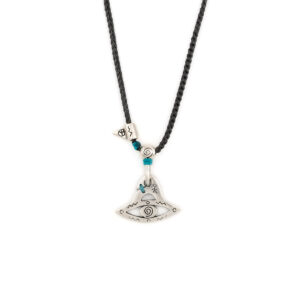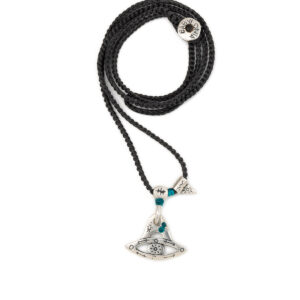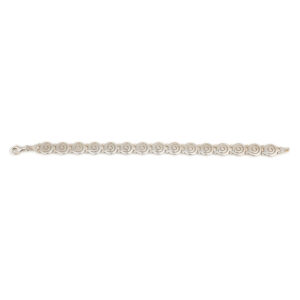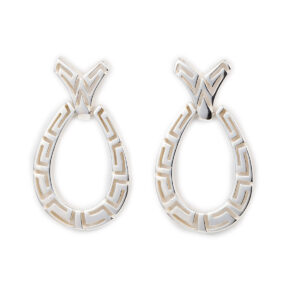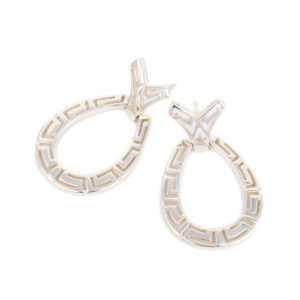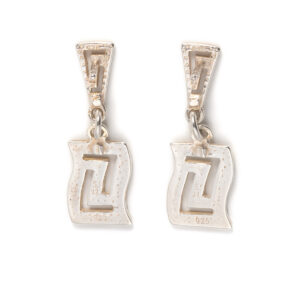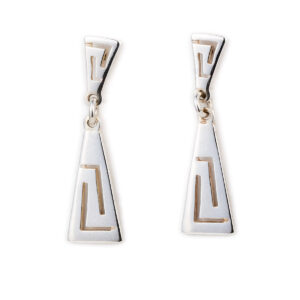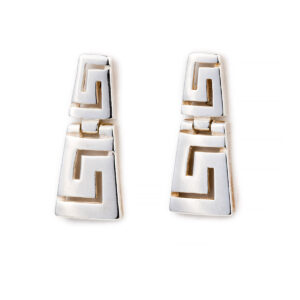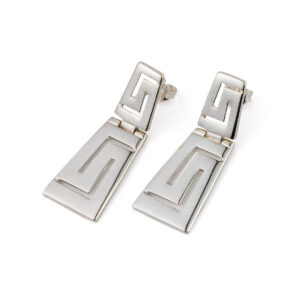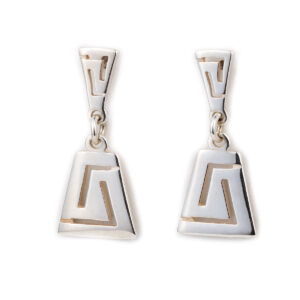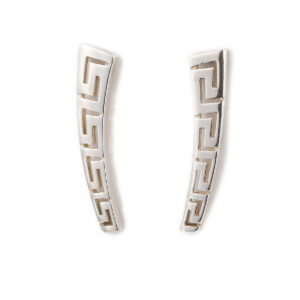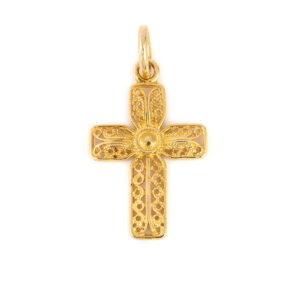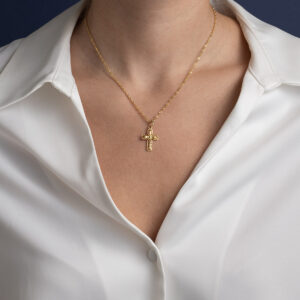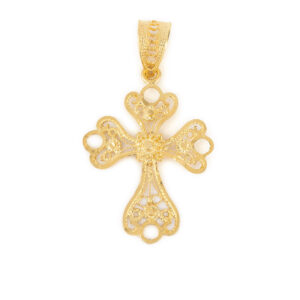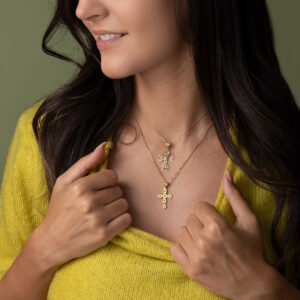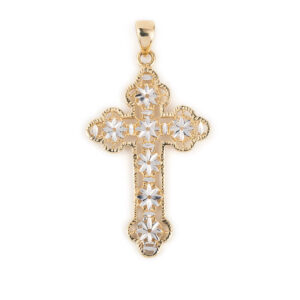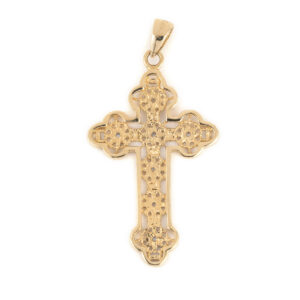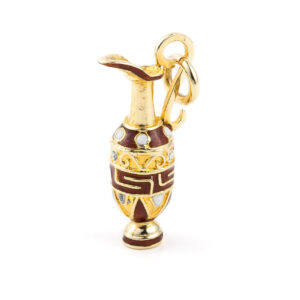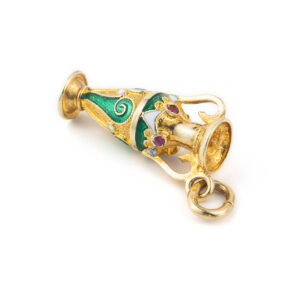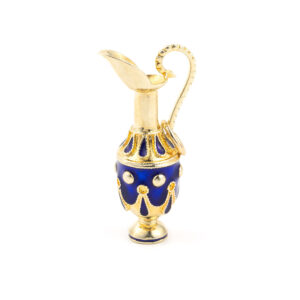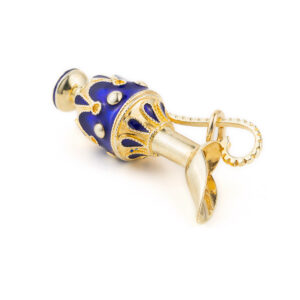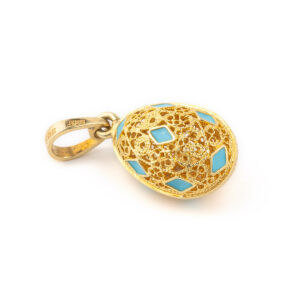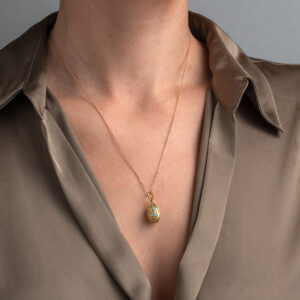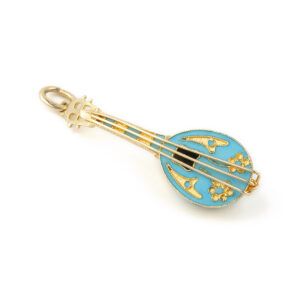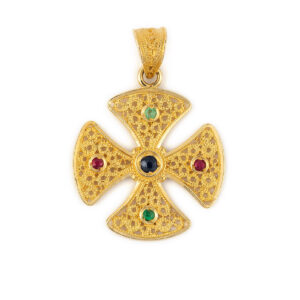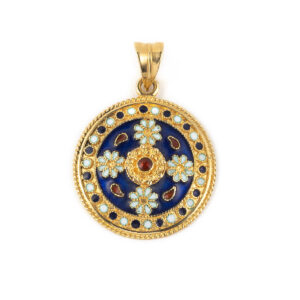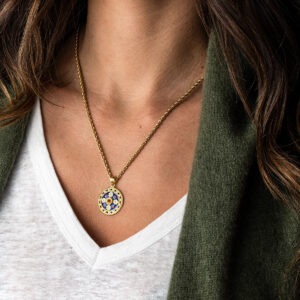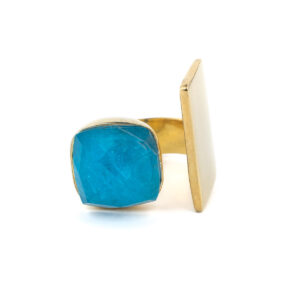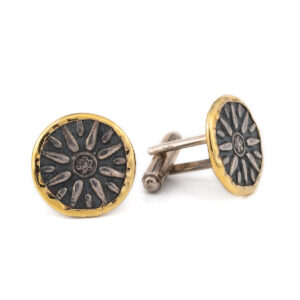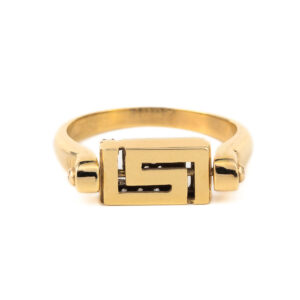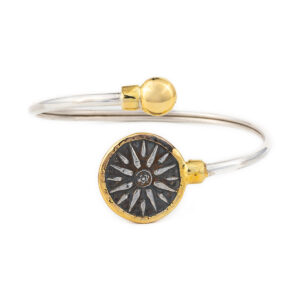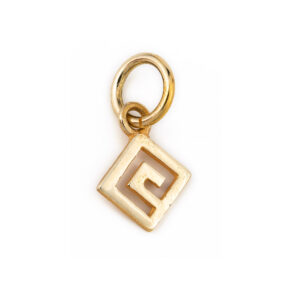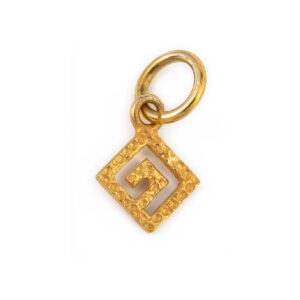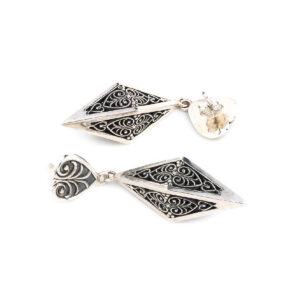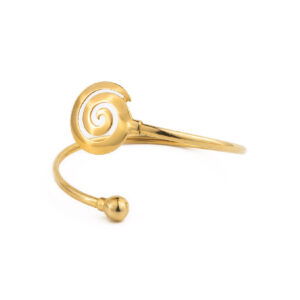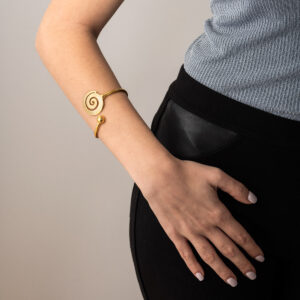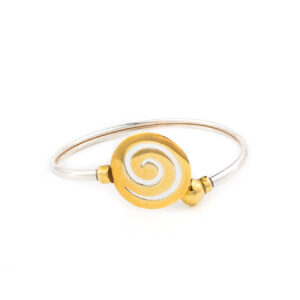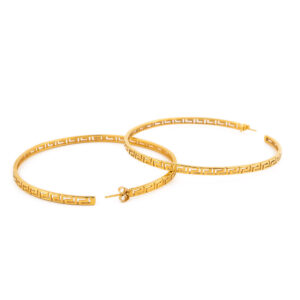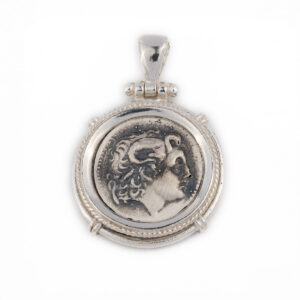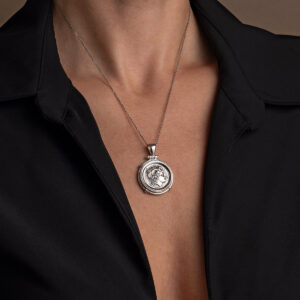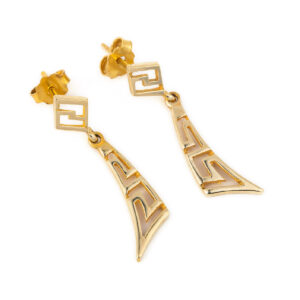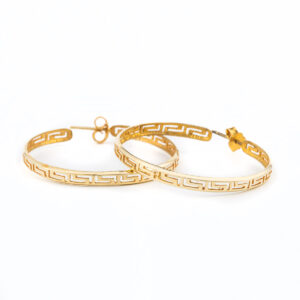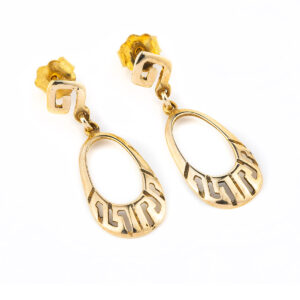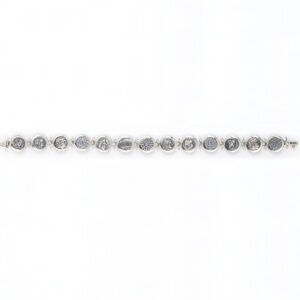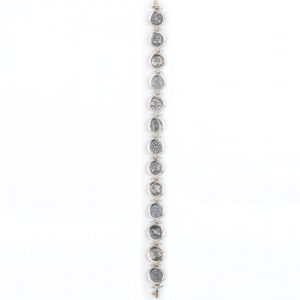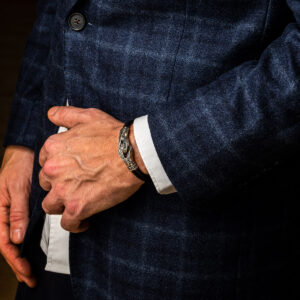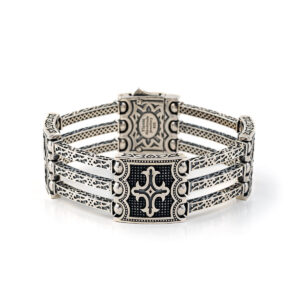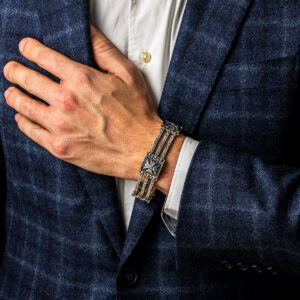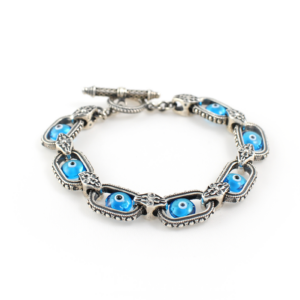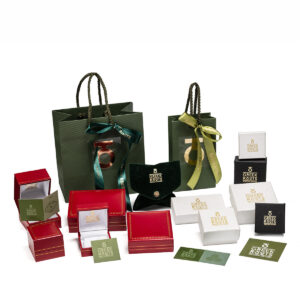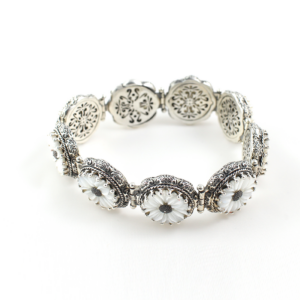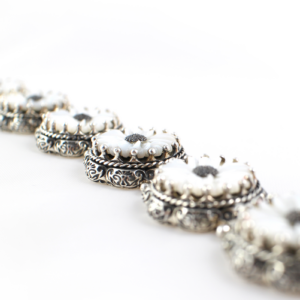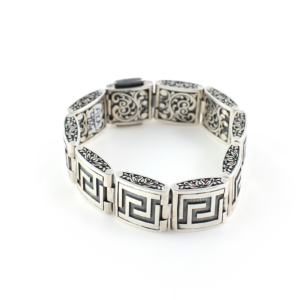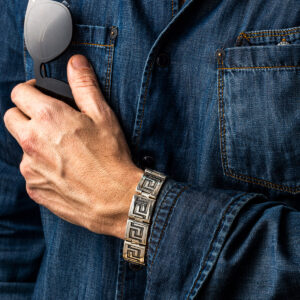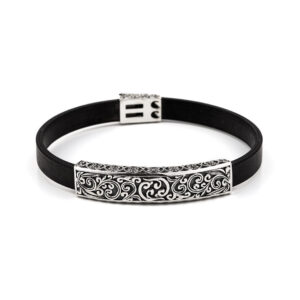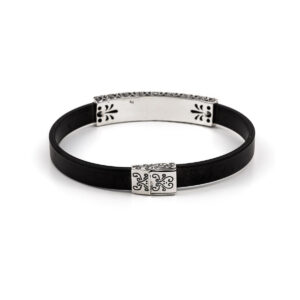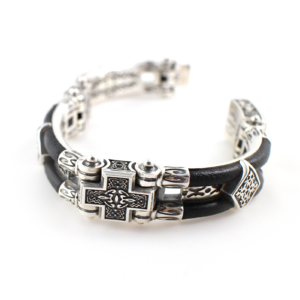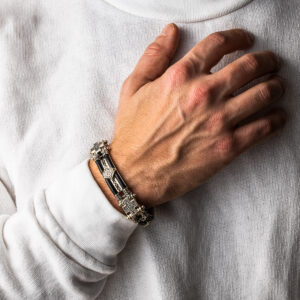Optimistic Ambitious – Babylonia Silver Necklace
120,00€Optimist Ambitious Necklace
Each Babylonia piece is uniquely engraved with a series of signs and symbols which are designed for self expression and individuality. You may select your desired piece, however it is the piece that chooses you.
Made in 935⁰ silver with special nautical knot
Unique handmade jewelry
Sterling Silver Bracelet with Spiral design
Bracelet with Spiral design.
The spiral is one of the oldest symbols of human spirituality, carved or painted into rocks thousands of years ago. Symbol of movement and progressive development, growth, expansion, cosmic energy, symbol of the sun. Spirals have been found in burial sites, in vases, in jewelry, clothing, weapons… They can be seen in every aspect in nature, like the tides in the oceans, the winds, the plants, the shells. The spiral phenomenon has been explained through mathematics from the time of Archimedes, the great Greek mathematician
Made in 925⁰ sterling silver
Handmade item.
Meander Teardrop Earrings
Earrings with Greek Key – Meander design.
Made of sterling silver 925°.
Handmade in Greece.
Explore Meandros Collection
Meandros design is a decorative border constructed from a continuous line, shaped into a repeated motif. Such a design is also called the Greek fret or Greek key design, although these are modern designations. On the one hand, the name “meander” recalls the twisting and turning path of the Meander River in Asia Minor, and on the other hand, as Karl Kerenyi pointed out, “the meander is the figure of a labyrinth in linear form” the meaning is that there is no beginning and no end in some cases so it becomes the symbol of long life and eternity.
Sterling Silver Meander Greek Key Earrings
Earrings with Greek Key – Meander design.
Made of sterling silver 925°.
Handmade in Greece.
Explore Meandros Collection
Meandros design is a decorative border constructed from a continuous line, shaped into a repeated motif. Such a design is also called the Greek fret or Greek key design, although these are modern designations. On the one hand, the name “meander” recalls the twisting and turning path of the Meander River in Asia Minor, and on the other hand, as Karl Kerenyi pointed out, “the meander is the figure of a labyrinth in linear form” the meaning is that there is no beginning and no end in some cases so it becomes the symbol of long life and eternity.
Greek Key Meander Dangle Earrings
Earrings with Greek Key – Meander design.
Made of sterling silver 925°.
Handmade in Greece.
Explore Meandros Collection
Meandros design is a decorative border constructed from a continuous line, shaped into a repeated motif. Such a design is also called the Greek fret or Greek key design, although these are modern designations. On the one hand, the name “meander” recalls the twisting and turning path of the Meander River in Asia Minor, and on the other hand, as Karl Kerenyi pointed out, “the meander is the figure of a labyrinth in linear form” the meaning is that there is no beginning and no end in some cases so it becomes the symbol of long life and eternity.
Sterling Silver Dangle Meander Earrings
Earrings with Greek Key – Meander design.
Made of sterling silver 925°.
Handmade in Greece.
Explore Meandros Collection
Meandros design is a decorative border constructed from a continuous line, shaped into a repeated motif. Such a design is also called the Greek fret or Greek key design, although these are modern designations. On the one hand, the name “meander” recalls the twisting and turning path of the Meander River in Asia Minor, and on the other hand, as Karl Kerenyi pointed out, “the meander is the figure of a labyrinth in linear form” the meaning is that there is no beginning and no end in some cases so it becomes the symbol of long life and eternity.
Sterling Silver Meander Stud Earrings
Earrings with Greek Key – Meander design.
Made of sterling silver 925°.
Handmade in Greece.
Explore Meandros Collection
Meandros design is a decorative border constructed from a continuous line, shaped into a repeated motif. Such a design is also called the Greek fret or Greek key design, although these are modern designations. On the one hand, the name “meander” recalls the twisting and turning path of the Meander River in Asia Minor, and on the other hand, as Karl Kerenyi pointed out, “the meander is the figure of a labyrinth in linear form” the meaning is that there is no beginning and no end in some cases so it becomes the symbol of long life and eternity.
Meander Dangle Earrings
Earrings with Greek Key – Meander design.
Made of sterling silver 925°.
Handmade in Greece.
Explore Meandros Collection
Meandros design is a decorative border constructed from a continuous line, shaped into a repeated motif. Such a design is also called the Greek fret or Greek key design, although these are modern designations. On the one hand, the name “meander” recalls the twisting and turning path of the Meander River in Asia Minor, and on the other hand, as Karl Kerenyi pointed out, “the meander is the figure of a labyrinth in linear form” the meaning is that there is no beginning and no end in some cases so it becomes the symbol of long life and eternity.
Meander Stud Earrings
Stud Earrings with Meander design. Meandros design is a decorative border constructed from a continuous line, shaped into a repeated motif. Such a design is also called the Greek fret or Greek key design, although these are modern designations. One the one hand, the name “meander” recalls the twisting and turning path of the Meander River in Asia Minor, and on the other hand, as Karl Kerenyi pointed out, “the meander is the figure of a labyrinth in linear form” the meaning is that these is no beginning and to end in some cases so it become the symbol of long life and eternity.
Handmade item
Byzantine Filigree Cross in 18K Gold
378,00€Byzantine Cross decorated with fine filigree.
Inspired by Byzantine art.
Made in 18k gold
Handmade item
Filigree is a delicate kind of jewellery metalwork, made with tiny beads or twisted threads, or both in combination, soldered together or to the surface of an object of the same metal and arranged in artistic motifs. The art of filigree dates back to ancient history. The first of the found jewelry in this technique has been found in Mesopotamia and dates to thousands of years BC. In the ancient world and particularly in Asia Minor, this art grew at the highest level.
Byzantine Filigree Cross in 14K Gold
299,00€Byzantine Filigree Cross in 14K Gold
Inspired by Byzantine art.
Made in 14k gold
Handmade item
Byzantine Cross in 14K Gold with Flowers
364,00€Byzantine Cross
Inspired by Byzantine art.
Made in 14k gold
Handmade item
14k Gold Pendant Amphora with Red enamel & Meander
620,00€Ancient Greek Amphora Pendant with red enamel and Meander design.
Design inspired by the ancient Greek history.
Made in 14k yellow gold
Also available with turquoise or blue enamel
Available in 3 sizes.
Handmade item.
The chain shown is our 14K Gold Chain (not included).
Amphora is a Greco – Roman word developed in ancient Greek during the Bronze Age. An amphora is a type of container of a characteristic shape and size. Amphorae were used for the transport and storage of various products, both liquid and dry, but mostly for wine. They are most often ceramic. the amphorae used in Ancient Greek vase painting. (source wikipedia)
Meander or Meandros design, one of the most historic symbols of the Greek World, also called Greek Key and symbolizes long life and eternity. The pattern with Meander was used in antiquity to decorate the frieze of temples.
14k Gold Pendant Amphora with enamel
620,00€Ancient Greek Amphora Pendant with green enamel.
Design inspired by the ancient Greek history.
Made in 14k yellow gold
Also available with red or turquoise enamel
Handmade item
Amphora is a Greco – Roman word developed in ancient Greek during the Bronze Age. An amphora is a type of container of a characteristic shape and size. Amphorae were used for the transport and storage of various products, both liquid and dry, but mostly for wine. They are most often ceramic. the amphorae used in Ancient Greek vase painting. (source wikipedia)
14k Gold Pendant Amphora with Blue enamel
1.648,00€Ancient Greek Amphora Pendant with blue enamel.
Design inspired by the ancient Greek history.
Made in 14k yellow gold
Also available with turquoise or green enamel
Handmade item
Amphora is a Greco – Roman word developed in ancient Greek during the Bronze Age. An amphora is a type of container of a characteristic shape and size. Amphorae were used for the transport and storage of various products, both liquid and dry, but mostly for wine. They are most often ceramic. the amphorae used in Ancient Greek vase painting. (source wikipedia)
14k Gold Filigree Egg Pendant with Turquoise enamel
602,00€The pendant is embellished with fine filigree and turquoise enamel in Faberge style. Also, the pendant is decorated with a floral design.
Used as a charm or as a pendant.
Pick up a beautiful gift inspired by the majestic art of Fabergé!
Made in 14k yellow gold.
The chain shown is our Cable Chain in 14K Gold (not included).
Filigree is a delicate kind of jewelry metalwork, made with tiny beads or twisted threads, or both in combination, soldered together or to the surface of an object of the same metal and arranged in artistic motifs. The art of filigree dates back to ancient history. The first of the found jewelry in this technique has been found in Mesopotamia and dates to thousands of years BC. In the ancient world, particularly in Asia Minor, this art grew at the highest level.
Fabergé egg is a jeweled egg created by the House of Fabergé, in St. Petersburg, Imperial Russia. Virtually all were manufactured under the supervision of Peter Carl Fabergé between 1885 and 1917,[citation needed] the most famous being the 50 “Imperial” eggs, 43 of which survive, made for the Russian Tsars Alexander III and Nicholas II as Easter gifts for their wives and mothers. The first Fabergé egg was crafted for Tsar Alexander III, who had decided to give his wife, Empress Maria Feodorovna, an Easter egg in 1885. Peter Carl Fabergé was a Russian jeweler best known for the famous Fabergé eggs made in the style of genuine Easter eggs, using precious metals and gemstones. He’s the founder of the famous jewelry legacy House of Fabergé. (Wikipedia)
14k Yellow Gold Greek Bouzouki Charm with Turquoise Enamel
920,00€Greek Bouzouki Charm with turquoise enamel decorated with rosette motifs.
Made in 14k yellow gold.
Used as a charm or as a pendant.
Handmade in Greece.
Design inspired by the Greek tradition.
Explore Heritage Collection
History
The Greek bouzouki is a plucked musical instrument of the lute family, called the thabouras or tambouras family. The tambouras existed in ancient Greece as the pandura, and can be found in various sizes and shapes. The bouzouki and the baglamas are the direct descendants. The bouzouki arrived in Greece following the 1919–1922 war in Asia Minor and the subsequent population exchange between Greece and Turkey. The early bouzoukia mostly had three courses. At the end of the 1950s, four-course (tetrachordo) bouzoukia started to gain popularity. The four-course bouzouki was made popular by Manolis Chiotis. Manolis Chiotis was a Greek rebetiko and laiko composer, singer, and bouzouki player. He is considered one of the greatest bouzouki soloists of all time.
Byzantine Cross in 18K Gold with rubies emeralds and sapphires
1.007,00€Byzantine Cross with rubies, emeralds and sapphires
Inspired by Byzantine art.
Made in 18k yellow gold
Handmade item.
The chain shown is our 14K Gold Rope Chain (not included).
As in all handmade items, there may be small differences in weight and dimensions and this is what makes them unique and precious.
18k Gold Blue Ancient Greek Floral Pendant
1.436,00€Ancient Greek Round Pendant with floral motif (four rosette motifs). The pendant is decorated with blue & red enamel and granules of precious metal. The back side of the pendant has no decoration.
Design inspired by the incredible beauty of historical tradition.
Made in 18k yellow gold
Also available with turquoise enamel
Handmade item.
The chain shown is our 14K Gold Rope Chain (not included).
This technique is called Granulation. Granulation (from Latin: granum = “grain”) is a jewellery technique whereby a surface of a jewel is covered with small spheres or granules of precious metal. The technique is thought to have its origins in Mesopotamia about 5,000 years ago.
The rosette (rose) is a timeless jewel, symbol and amulet. The origin of the term is the Greek word for rose – rodon (ρόδον). Its use began in the Mycenaean era and continues as far as the 2nd millennia BC. The Mycenaean Rosette is a motif that was widespread throughout Mesopotamia, Egypt, Greece and other ancient civilizations. It is inspired by a Mycenaean rosette bead, found at Mycenae, dated to 1400-1300 B.C. The rosette was used extensively in ancient Greek Mycenaean jewels, in architecture, pottery and in sculptures from 1500 BC. Mycenaean rosettes usually had 6 or 8 or 12 leaves, and sixteen leaves during the Macedonian Dynasty. Such details as the rodax shape and the number of leaves tend to vary with the era or beliefs. The rosettes were used to decorate the cloths, belts and wreaths of the Kings. The number of leaves had a symbolic character each time. The four elements of nature (wind, earth, fire, water), the seven wonders of the ancient world or the twelve gods of ancient Greeks and the world domination and radiance of the Kings of Macedonia. They were signs of beauty, purity, eugenics, worship and power. Rosette or Rodax was probably the most popular and favorite decorative element in Mycenaean era, classical antiquity and Byzantine times.
Gold Plated Blue Apatite Doublet Ring
This ring features a beautiful doublet apatite gemstone in a deep blue colour
Made in sterling silver 925°and gold plated.
Doublet jewelry is a very special piece of jewel due to the way it is compounded. Doublet is a modern and very fashionable design that was invented in order to make stones such as lapis lazuli, turquoise and other non-transparent stones glow and create unique colors from them. There is the unification of two gemstones, which usually consist of quartz and another nontransparent stone. Quartz in this case gives radiance to the other stone and also volume. Due to its composition doublet jewelry needs to be looked after. To keep them in good shape you need to avoid contact with chemicals, such as soap or perfumes. Quartz has the tendency to lose its shininess when touched with sweaty hands, we advise you from time to time to use a soft cloth to polish and give brightness to it.
Vergina Star Cufflinks – 14K Gold and Sterling Silver
A pair of Greek gold cuff links with the Vergina sun.
Made in 925°sterling silver and 14K gold.
Handmade item. As in all handmade items, there may be small differences in weight and dimensions and this is what makes them unique and precious.
The Vergina Sun also known as the “Star of Vergina” is a rayed solar symbol appearing in ancient Greek art. The Vergina Sun proper has sixteen triangular rays. The name “Vergina Sun” became widely used after the archaeological excavations in and around the small town of Vergina, in northern Greece, during the late 1970s.
14K Gold Meander Flip Ring with white crystals
792,00€Meander Ring in 14k Gold with white crystals inspired by the ancient Greek design the Meander or Greek Key.
Meandros design is a decorative border constructed from a continuous line, shaped into a repeated motif. Such a design is also called the Greek fret or Greek key design, although these are modern designations. On the one hand, the name “meander” recalls the twisting and turning path of the Meander River in Asia Minor, and on the other hand, as Karl Kerenyi pointed out, “the meander is the figure of a labyrinth in linear form” the meaning is that there is no beginning and no end in some cases so it becomes the symbol of long life and eternity.
Handmade item.
Meander Ring 14k Gold
920,00€Ring inspired by the ancient Greek design of the Meander or Greek Key.
Made of 14k Gold
Meandros design is a decorative border constructed from a continuous line, shaped into a repeated motif. Such a design is also called the Greek fret or Greek key design, although these are modern designations. On the one hand, the name “meander” recalls the twisting and turning path of the Meander River in Asia Minor, and on the other hand, as Karl Kerenyi pointed out, “the meander is the figure of a labyrinth in linear form” the meaning is that there is no beginning and no end in some cases so it becomes the symbol of long life and eternity.
As in all handmade items, there may be small differences in weight and dimensions and this is what makes them unique and precious.
Vergina Star Hinge Bracelet
Bracelets inspired by the ancient Vergina sun symbol.
Made in 925°sterling silver and 14K gold.
Handmade in Greece.
History
The Vergina Sun also known as the “Star of Vergina”, “Macedonian Star” is a rayed solar symbol appearing in ancient Greek art. The Vergina Sun proper has sixteen triangular rays. The name “Vergina Sun” became widely used after the archaeological excavations in and around the small town of Vergina, in northern Greece, during the late 1970s. In older references, the name “Argead Star” or “Star of the Argeadai” is used for the Sun as the royal symbol of the dynasty of Macedon. There it was depicted on a golden larnax found in a 4th-century BC royal tomb belonging to either Philip II or Philip III of Macedon, the father and half-brother of Alexander the Great, respectively.
Gold Meandros Pendant
149,00€14k Gold Meandros Pendant.
Meandros design is a decorative border constructed from a continuous line, shaped into a repeated motif. Such a design is also called the Greek fret or Greek key design, although these are modern designations. One the one hand, the name “meander” recalls the twisting and turning path of the Meander River in Asia Minor, and on the other hand, as Karl Kerenyi pointed out, “the meander is the figure of a labyrinth in linear form” the meaning is that these is no beginning and to end in some cases so it become the symbol of long life and eternity.
Handmade item.
Byzantine Geometric Chandelier Silver Earrings – Yianni Jewelry
Byzantine Geometric Earrings with floral motifs.
Black oxidized background.
Made in 925° sterling silver.
Handmade earrings. The shape and decoration of these earrings shows the influence of the Byzantine art.
These silver creations of Yianni Jewelry, created by Garbis Khacherian, a silversmith trader since 1987.
Byzantine Filigree Drop Silver Pendant – Yianni Jewelry
This beautiful pendant represents the Byzantine design and ancient floral symbol.
Black oxidized background.
Made in 925° sterling silver.
Handmade Item.
Silver creations of Yianni Jewelry, created by Garbis Khacherian, a silversmith trader since 1987.
Spiral Hinge Bracelet – 925 Sterling Silver and Gold Plated
Gold Plated Bangle Bracelet with spiral design. The spiral is one of the oldest symbols of human spirituality, carved or painted into rocks thousands of years ago. Symbol of movement and progressive development, growth, expansion, cosmic energy, symbol of the sun. Spirals have been found in burial sites, in vases, in jewelry, clothing, weapons… They can be seen in every aspect of nature, like the tides in the oceans, the winds, the plants, and the shells. The spiral phenomenon has been explained through mathematics from the time of Archimedes, the great Greek mathematician.
The bracelet is bendable and one-size only.
Handmade item.
Spiral Hinge Bracelet – 925 Sterling Silver and Gold Plated
Silver Bracelet with spiral design. The spiral is one of the oldest symbols of human spirituality, carved or painted into rocks thousands of years ago. Symbol of movement and progressive development, growth, expansion, cosmic energy, symbol of the sun. Spirals have been found in burial sites, in vases, in jewelry, clothing, weapons… They can be seen in every aspect of nature, like the tides in the oceans, the winds, the plants, the shells. The spiral phenomenon has been explained through mathematics from the time of Archimedes, the great Greek mathematician.
The bracelet is bendable and one-size only.
Handmade item.
Gold Plated Meander Hoop Earrings
Earrings with Greek Key – Meander design.
Made of sterling silver 925° and gold plated.
Handmade in Greece.
Explore Meandros Collection
Meandros design is a decorative border constructed from a continuous line, shaped into a repeated motif. Such a design is also called the Greek fret or Greek key design, although these are modern designations. On the one hand, the name “meander” recalls the twisting and turning path of the Meander River in Asia Minor, and on the other hand, as Karl Kerenyi pointed out, “the meander is the figure of a labyrinth in linear form” the meaning is that there is no beginning and no end in some cases so it becomes the symbol of long life and eternity.
Alexander the Great & Lysimachus Coin Pendant
Ancient Greek coin representing Alexander the Great on one side and King Lysimachus on the other. Alexander the Great the King of Macedonia is considered one of the most important forms of world history. Lysimachus was a Macedonian officer and diadochus of Alexander the Great, who became a basileus in 306 BC, ruling Thrace, Asia Minor and Macedon.
Made in 925⁰ sterling silver.
Black oxidized background.
Handmade item.
Phaistos Disc Pendant
Phaistos Disc Pendant in sterling silver.
The Phaistos Disc is a disk of fired clay from the Minoan palace of Phaistos on the island of Crete. Now, the island of Crete is part of modern Greece. The disc was discovered in 1908 by the Italian archaeologist Luigi Pernier in the Minoan palace-site of Phaistos. While it is not clear that it is a script, most attempted decipherments assume that it is; most additionally assume a syllabary, others an alphabet or logography or a calendar.
Handmade item.
The chain shown is our Sterling Silver Cable Chain – Length 45 cm (not included).
14K Gold Ancient Corinthian Greek Column
728,00€Used as a charm on a bracelet or as a pendant on a chain.
Made in 14k gold.
Handmade item.
History
The Corinthian order is named for the Greek city of Corinth, to which it was connected in the period. There are three distinct orders in Ancient Greek architecture: Doric, Ionic, and Corinthian. The Corinthian order is the last developed of the three principal classical orders of ancient Greek and Roman architecture. The Corinthian, with its offshoot the Composite, is the most ornate of the orders. This architectural style is characterized by slender fluted columns and elaborate capitals decorated with acanthus leaves and scrolls. Also there are many variations. The Corinthian Order in 334 BC it appeared as an external feature on the Choragic Monument of Lysicrates in Athens, and then used on a huge scale at the Temple of Zeus Olympia in Athens.
14K Gold Geometrical Meander Earrings
665,00€Made in 14k gold.
Explore Meandros Collection
Meandros design is a decorative border constructed from a continuous line, shaped into a repeated motif. Such a design is also called the Greek fret or Greek key design, although these are modern designations. On the one hand, the name “meander” recalls the twisting and turning path of the Meander River in Asia Minor, and on the other hand, as Karl Kerenyi pointed out, “the meander is the figure of a labyrinth in linear form” the meaning is that there is no beginning and no end in some cases so it becomes the symbol of long life and eternity.
14K Gold Meander Dangling Earrings
556,00€Made in 14k gold.
Explore Meandros Collection
Meandros design is a decorative border constructed from a continuous line, shaped into a repeated motif. Such a design is also called the Greek fret or Greek key design, although these are modern designations. On the one hand, the name “meander” recalls the twisting and turning path of the Meander River in Asia Minor, and on the other hand, as Karl Kerenyi pointed out, “the meander is the figure of a labyrinth in linear form” the meaning is that there is no beginning and no end in some cases so it becomes the symbol of long life and eternity.
14k Gold Meander Hoop Earrings
1.136,00€Made in 14k gold.
Explore Meandros Collection
Meandros design is a decorative border constructed from a continuous line, shaped into a repeated motif. Such a design is also called the Greek fret or Greek key design, although these are modern designations. On the one hand, the name “meander” recalls the twisting and turning path of the Meander River in Asia Minor, and on the other hand, as Karl Kerenyi pointed out, “the meander is the figure of a labyrinth in linear form” the meaning is that there is no beginning and no end in some cases so it becomes the symbol of long life and eternity.
14k Gold Meander Earrings
495,00€Made in 14k gold.
Explore Meandros Collection
Meandros design is a decorative border constructed from a continuous line, shaped into a repeated motif. Such a design is also called the Greek fret or Greek key design, although these are modern designations. On the one hand, the name “meander” recalls the twisting and turning path of the Meander River in Asia Minor, and on the other hand, as Karl Kerenyi pointed out, “the meander is the figure of a labyrinth in linear form” the meaning is that there is no beginning and no end in some cases so it becomes the symbol of long life and eternity.
Ancient Greek Coin Link Bracelet – 925 Sterling Silver
Bracelet with Ancient Greek symbols.
This is a beautiful silver bracelet with ancient coins (replicas) representing different symbols from ancient Greek history and mythology (Spiral Of Life, ancient Greek Gods).
Made in 925⁰ sterling silver.
Handmade item.
Spiral Earrings
Spiral Earrings. The spiral is one of the oldest symbols of human spirituality, carved or painted into rocks thousands of years ago. Symbol of movement and progressive development, growth, expansion, cosmic energy, symbol of the sun.. Spirals have been found in burial sites, in vases, in jewelry, clothing, weapons… They can be seen in every aspect in nature, like the tides in the oceans, the winds, the plants, the shells. The spiral phenomenon has been explained through mathematics from the time of Archimedes, the great Greek mathematician.
Handmade item.
Mother of Pearl Silver Earrings – Yianni Jewelry
A pair of beautiful mother of pearl earrings.
Made in 925° sterling silver.
Handmade item.
These silver creations of Yianni Jewelry, created by Garbis Khacherian, a silversmith trader since 1987.
Byzantine Motif Link Bracelet – Sterling Silver Yianni Jewelry
Link Bracelet with Byzantine motifs and great attention to detail
Design inspired by Byzantine Jewelry.
Black oxidized background.
Made in 925⁰ sterling silver
Handmade item.
Silver creations of Yianni Jewelry, created by Garbis Khacherian, a silversmith trader since 1987.
Hercules Leather Bracelet – Sterling Silver Yianni Jewelry
Bracelet with Hercules knot and leather strap.
It features two rows of smooth black leather cords with an engraved sterling silver clasp to hold them in place. The unique rope knot station in the front is etched with a free flow design in sterling silver with darkened crevices.
Handmade item.
Silver creations of Yianni Jewelry, created by Garbis Khacherian, a silversmith trader since 1987.
Byzantine Bracelet with Cross – Sterling Silver Yianni Jewelry
Bracelet with Cross
The decoration of this bracelet shows the influence of Byzantine art.
Black oxidized background.
Made of 925⁰ sterling silver
Handmade item.
Silver creations of Yianni Jewelry, created by Garbis Khacherian, a silversmith trader since 1987.
Evil Eye Link Bracelet – Sterling Silver Yianni Jewelry
Link Bracelet with the evil eye symbol.
Made of 925° sterling silver.
Handmade Item.
Silver creations of Yianni Jewelry, created by Garbis Khacherian, a silversmith trader since 1987.
Byzantine Mother Of Pearl Bracelet – Sterling Silver Yianni Jewelry
A very beautiful bracelet decorated with mother of pearl. Design inspired by Byzantine Jewelry.
Black oxidized background.
Made of 925⁰ sterling silver
Handmade item.
Silver creations of Yianni Jewelry, created by Garbis Khacherian, a silversmith trader since 1987.
Meander Link Bracelet – 925 Sterling Silver – Yianni Jewelry
Two-sided bracelet. On one side, the bracelet is decorated with the Ancient Greek meander symbol and Byzantine motifs on the other.
Meandros design is a decorative border constructed from a continuous line, shaped into a repeated motif. Such a design is also called the Greek fret or Greek key design, although these are modern designations. On the one hand, the name “meander” recalls the twisting and turning path of the Meander River in Asia Minor, and on the other hand, as Karl Kerenyi pointed out, “the meander is the figure of a labyrinth in linear form” the meaning is that there is no beginning and no end in some cases so it becomes the symbol of long life and eternity.
Black oxidized background.
Made in 925⁰ sterling silver
Handmade item.
Silver creations of Yianni Jewelry, created by Garbis Khacherian, a silversmith trader since 1987.
Byzantine Floral Bracelet – Sterling Silver Yianni Jewelry
Floral Bracelet Byzantine design.
Silver oxidized finish.
Handmade Item.
Made in 925° sterling silver.
Silver creations of Yianni Jewelry, created by Garbis Khacherian, a silversmith trader since 1987.
Byzantine Cross Leather Bracelet – Sterling Silver Yianni Jewelry
Byzantine Cross Leather Bracelet with double leather strap and engraved motifs (cross, floral motifs) on sterling silver with pave spinel bar.
Silver oxidized finish.
Handmade Item.
Silver creations of Yianni Jewelry, created by Garbis Khacherian, a silversmith trader since 1987.

